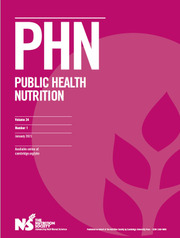Monitoring and surveillance
Research paper
Streamlined data-gathering techniques to estimate the price and affordability of healthy and unhealthy diets under different pricing scenarios
-
- Published online by Cambridge University Press:
- 14 July 2020, pp. 1-11
-
- Article
-
- You have access
- HTML
- Export citation
Assessment of trans-fatty acid content in a sample of foods from the Slovenian food supply using a sales-weighting approach
-
- Published online by Cambridge University Press:
- 28 July 2020, pp. 12-21
-
- Article
-
- You have access
- HTML
- Export citation
Assessment and methodology
Research paper
Concordance of children’s intake of selected food groups as reported by parents via 24-h dietary recall and ecological momentary assessment
-
- Published online by Cambridge University Press:
- 24 June 2020, pp. 22-33
-
- Article
-
- You have access
- HTML
- Export citation
Relative validity of a computer-based semi-quantitative FFQ for use in the Pelotas (Brazil) Birth Cohort Studies
-
- Published online by Cambridge University Press:
- 29 June 2020, pp. 34-42
-
- Article
-
- You have access
- HTML
- Export citation
Nutritional status and body composition
Research paper
Evaluation of nutritional status of foreign students at King Saud University, Kingdom of Saudi Arabia
-
- Published online by Cambridge University Press:
- 26 August 2020, pp. 43-51
-
- Article
-
- You have access
- HTML
- Export citation
Catch-up growth is a better indicator of undernutrition than thresholds for stunting
-
- Published online by Cambridge University Press:
- 14 September 2020, pp. 52-61
-
- Article
-
- You have access
- Open access
- HTML
- Export citation
Nutrition communication
Research paper
The efficacy of ‘high in’ warning labels, health star and traffic light front-of-package labelling: an online randomised control trial
- Part of:
-
- Published online by Cambridge University Press:
- 06 October 2020, pp. 62-74
-
- Article
-
- You have access
- HTML
- Export citation
Behavioural nutrition
Research paper
A goal-systems perspective on plant-based eating: keys to successful adherence in university students
- Part of:
-
- Published online by Cambridge University Press:
- 09 June 2020, pp. 75-83
-
- Article
-
- You have access
- Open access
- HTML
- Export citation
Nutritional epidemiology
Research paper
Dietary patterns generated by the Treelet Transform and risk of stroke: a Danish cohort study
-
- Published online by Cambridge University Press:
- 24 October 2020, pp. 84-94
-
- Article
-
- You have access
- HTML
- Export citation
Body image disorders associated with lifestyle and body composition of female adolescents
-
- Published online by Cambridge University Press:
- 17 April 2020, pp. 95-105
-
- Article
-
- You have access
- HTML
- Export citation
Economics and environment
Research paper
Maternal height and double-burden of malnutrition households in Mexico: stunted children with overweight or obese mothers
-
- Published online by Cambridge University Press:
- 01 September 2020, pp. 106-116
-
- Article
-
- You have access
- HTML
- Export citation
Community nutrition
Research paper
Food deserts and cardiovascular health among young adults
-
- Published online by Cambridge University Press:
- 09 July 2020, pp. 117-124
-
- Article
-
- You have access
- HTML
- Export citation
The University of British Columbia healthy beverage initiative: changing the beverage landscape on a large post-secondary campus
-
- Published online by Cambridge University Press:
- 18 September 2020, pp. 125-135
-
- Article
-
- You have access
- HTML
- Export citation
Invited Commentary
Healthy beverage initiatives in higher education: an untapped strategy for health promotion
-
- Published online by Cambridge University Press:
- 22 October 2020, pp. 136-138
-
- Article
-
- You have access
- HTML
- Export citation
Interventions
Research paper
Guidance materials from 2014 to 2019 on nutritional care for Ebola patients in Ebola Treatment Units: an analysis
-
- Published online by Cambridge University Press:
- 20 August 2020, pp. 139-145
-
- Article
-
- You have access
- Open access
- HTML
- Export citation
The role of improved social support for healthy eating in a lifestyle intervention: Texercise Select
-
- Published online by Cambridge University Press:
- 24 August 2020, pp. 146-156
-
- Article
-
- You have access
- HTML
- Export citation
Evaluating the effect of the initiative ‘Caring for the Newborn and the Mother at Home’ in Mexico
-
- Published online by Cambridge University Press:
- 07 October 2020, pp. 157-168
-
- Article
-
- You have access
- Open access
- HTML
- Export citation
Public policies
Research paper
Perspectives from South African dietitians on infant and young child feeding regulations
-
- Published online by Cambridge University Press:
- 27 May 2020, pp. 169-181
-
- Article
-
- You have access
- HTML
- Export citation
List of Reviewers
PHN List of Reviewers
-
- Published online by Cambridge University Press:
- 13 November 2020, pp. 182-191
-
- Article
-
- You have access
- HTML
- Export citation
Front Cover (OFC, IFC) and matter
PHN volume 24 issue 1 Cover and Front matter
-
- Published online by Cambridge University Press:
- 22 December 2020, pp. f1-f2
-
- Article
-
- You have access
- Export citation



